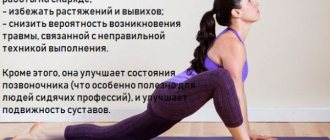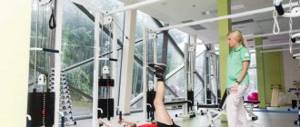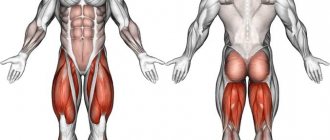Indications and contraindications
Exercise therapy for the spine is prescribed after an attack or exacerbation of the disease has resolved. The goal is to stimulate the regeneration of damaged tissues.
Indications:
- Osteochondrosis.
- Scoliosis and other types of spinal curvatures.
- Rehabilitation of the patient after surgery or injury.
- Intervertebral hernia.
- Other diseases of the spine.
Exercise therapy exercises do not eliminate pathology, but help the body cope with the problem on its own and reduce the severity of the following unpleasant symptoms:
- Pain.
- Edema.
- Impaired sensitivity.
- Weakness.
- Dizziness, fluctuations in blood pressure if a problem occurs against the background of a corresponding disease.
Specialized exercises for the spine belong to the group of non-invasive methods for treating and preventing pathologies; however, there are situations when the use of physical activity is not allowed.
Contraindications:
- Acute injury.
- A condition of the body that threatens the patient's life.
- Hematomas in areas amenable to physical activity.
- Neoplasms of a benign or malignant nature.
Features of training
To increase the effect of training, you should pay attention to a number of points:
- the load on the body should be increased gradually; you should not start training with maximum loads, as this may negatively affect the condition of the back;
- every movement must be done slowly and smoothly, twitching and jerking are strictly prohibited;
- suitable training frequency is 3-4 times a week;
- During training, breathing should be calm;
- you need to do it systematically, even skipping one workout introduces a certain glitch in the program;
- For training, you need to choose comfortable clothes, as this directly affects the effect.
If you follow these rules and perform the exercises correctly, strengthening your back at home will not be difficult.
Rules
Before starting any exercise, you should consult your doctor. It is important to understand that each body is differently prepared for physical activity. Professional athletes require rehabilitation, which is significantly different from the recovery period for a patient leading a sedentary lifestyle.
When selecting a set of exercises, you need to pay attention to the following features:
- Physical preparation of the body.
- Recovery period stage. In the early stages (2-7 days after injury or exacerbation of the disease), gentle therapeutic exercises for the spine are more in demand than active loads.
Basic rules for successful exercise therapy to strengthen your back:
- Training should be regular - 2 times a day. The duration of therapy is determined by the doctor.
- The exercises are performed smoothly without strain.
- The load gradually increases.
- Exercises are performed with “feeling”. It is necessary to work the muscles and ligaments, and not mechanically repeat memorized movements.
With proper exercise therapy, the patient feels a rush of blood to the corresponding area of the back. Warmth appears, and the volume of free movements gradually increases.
Execution Rules
The following technique is recommended:
- the room must be ventilated;
- exercises are performed in loose clothing so as not to restrict movement;
- classes should be carried out half an hour before meals or two hours after meals;
- correctly combine breathing with movement;
- bending and arching of the back is performed smoothly, without jerking, gradually increasing the amplitude of the execution;
- exercises are done until slight fatigue appears in the abdominal muscles;
- exercises intended for the cervical spine are performed very carefully, as excessive zeal can cause harm;
- the load should be increased gradually, monitoring your pulse;
- physical exercises should begin with rocking, gradually moving on to power loads.
- The pulse during exercise should not increase by more than 30%.
Exercises to strengthen the spine
Exercise therapy for diseases of the spine involves the selection of an individual training program for each patient, depending on the nature of the damage to his vertebrae, muscles and other structures.
In practice, basic exercises are highlighted that are suitable for almost all patients. Physical activity is aimed at primary strengthening of the back with stimulation of blood supply to the spinal column.
List of exercises:
- In a sitting or standing position, the patient contracts the anterior abdominal muscles as much as possible, but without moving the body. The tension is held for a few seconds, then you need to relax.
- In a position on all fours (knee-elbow or knee-palm), the patient smoothly raises his head to the ceiling with the back arched down. Then the reverse movement is carried out - head down and back up.
- Smooth bends and turns of the body in different directions.
The number of repetitions of the exercises depends on the patient’s well-being. Traditionally, it is recommended to perform the described movements from 3 to 10 times twice a day.
A set of simple exercises
There are a number of other manipulations that can improve the condition of the spinal muscles when a person makes a minimal amount of effort. These include the following:
Sarpasana. This pose is widespread in yoga and is called snake pose. To play it, you need to connect your legs and pull your shoulders up as much as possible. This exercise can prevent the development of various diseases of the musculoskeletal system, but it is not able to cure them.
Lumbar twist. To perform this, you need to lie down, and then, without separating your shoulders from the floor covering, try to touch your knees to the opposite side.
Baby pose. You need to lie on the floor, grab your knees with your hands and lift them to the sternum, the lumbar area is allowed to be lifted off the mat. This position should be held for half a minute.
Using a fitball. If you are interested in exercises to strengthen your back on a machine at home, then you should opt for such a sports element as a fitball. To improve the condition of the back muscles, you should lie down on the ball with your stomach and relax. You are allowed to lie in this position for an unlimited amount of time.
Keeping your legs static. To reproduce, you should place your limbs above your back (you can use a chair for these purposes) - this will ensure blood flow to the lumbar area and relieve pain.
Using hyperextension. It is necessary to pull the torso up so that it, together with the lower limbs, forms a straight line; this position should be maintained for half a minute.
If you have a trained body, it is quite possible to perform such manipulations dynamically.
Hip stretch. You need to lie down and bend your leg at the knee, placing the other one under it. The limbs are pulled toward the chest to stretch the back muscles and muscles in the hips.
Exercise therapy for diseases
The specific localization of the pathological process necessitates the need to perform separate exercises aimed at stabilizing the condition of the damaged structure. Below we will describe training options for different areas of the spine.
Cervical
The cervical spine is characterized by high mobility, which requires caution when performing physical activity after injury or illness.
Exercise options:
- The patient lies quietly in bed. Smoothly, without excessive effort, you need to press your head into a soft pillow. The indicated position is held for up to 5 seconds, after which a phase of total relaxation follows.
- Light hand pressure on the temporal area with the head tilted in the opposite direction to create reverse tension. The duration of the exercise is 5-10 seconds.
- Smooth maximum movement of the head back in a standing position while simultaneously pulling the chin to the chest.
Number of repetitions – 3-10. Sometimes, if the patient’s condition is satisfactory, it is recommended to perform circular rotations of the head around its axis. The exercise is contraindicated in patients with previous neck injuries and instability in the affected area.
Lumbar
Exercise options for patients with lower back pathology:
- In the supine position with the knees bent and resting on the feet, the patient smoothly lifts the pelvis up and holds for up to 10 seconds.
- The starting position is the same as in the previous exercise, but the legs are located to the right or left of the body. Using his knees, the patient tries to slowly reach the floor without jerking, without lifting his shoulder blades from the floor.
- Starting position on all fours. The patient smoothly extends his legs bent at the knees alternately.
- Lying on his back, the patient pulls one leg to his chest and slowly rocks on his back and buttocks. Then the relaxation stage and changing the lower limb.
The selection of exercises should be carried out with a doctor to prevent the development of undesirable consequences.
Therapeutic exercise
Exercise helps get rid of pain, strengthen muscles, speed up metabolism, improve blood circulation, correct posture problems and restore the spinal column.
For preventive purposes, the following exercises for the spine are recommended:
- for stretching - help relax the nerve branches of the spinal cord;
- to increase mobility, activate ligaments and muscles, improve flexibility;
- to strengthen muscle tissue and ligaments and relieve stress on the back.
Exercises should be performed systematically, it is better to do them twice a day: in the mornings and evenings. Exercises should be done slowly, smoothly and gradually increase the load every day. The correct approach to execution is important; you need to feel your spine.
Therapeutic exercises aimed at decompressing (stretching) the vertebra:
- Hanging on the gymnastics wall. It is recommended to bend over a little and move your legs back.
- Lean on the desk with your hands, place your elbows under the costal arches. Without lifting your feet from the floor, bend your torso forward.
- Lie on your stomach, stretch your arms forward and stretch, try to stretch the lumbar spine.
For mobility, it is good to do the following exercises:
- Stand up straight, hands on your waist. Bend forward, touching your palms to the floor.
- Stand straight, hands on your belt. Lean left and right 10-15 times.
- Stand straight, feet shoulder-width apart, arms down. Rotate your body in different directions.
- Stand up straight, arms down. Bend your leg at the knee joint, take it with both hands and pull it to your chest.
- Stand up straight, hands on your belt. Move your pelvis forward and backward.
- Stand up straight, perform lateral bends with your torso to the left and right.
- Lean your hand on a table or chair and swing your leg forward and backward, increasing the amplitude as much as possible.
- Sitting on the floor, stretch your legs. Bend your torso, reaching your toes with your hand.
- Lie on your back, arms along your body. Slowly bend your leg and clasp it with both hands and press it to your chest.
Exercise therapy to strengthen the muscle corset:
- Lie on your back, arms at your sides. Raise your head and toes at the same time. Hold for 5-10 seconds.
- Perform a stand on the shoulders and back of the head, hold for 10-40 seconds.
- Sit on a chair, hands behind your head. When stretching, bend back. Stay in this position for 2-5 seconds.
- Lie on your stomach. Bend over and raise your arms and legs at the same time. Stay in this position for about 5 seconds.
- Lying on your back, place your hands on the floor at shoulder level. Bend your back and without bending your legs, lift your shoulder girdle up. Lie on your back, legs half-bent, arms along your body. Bend in the thoracic and lumbar regions. Hold for 5-7 seconds.
Choose the number of repetitions and load according to how you feel. When using exercise therapy you need to be patient. To restore the spinal column and prevent diseases
You need a long time and systematic exercise.











